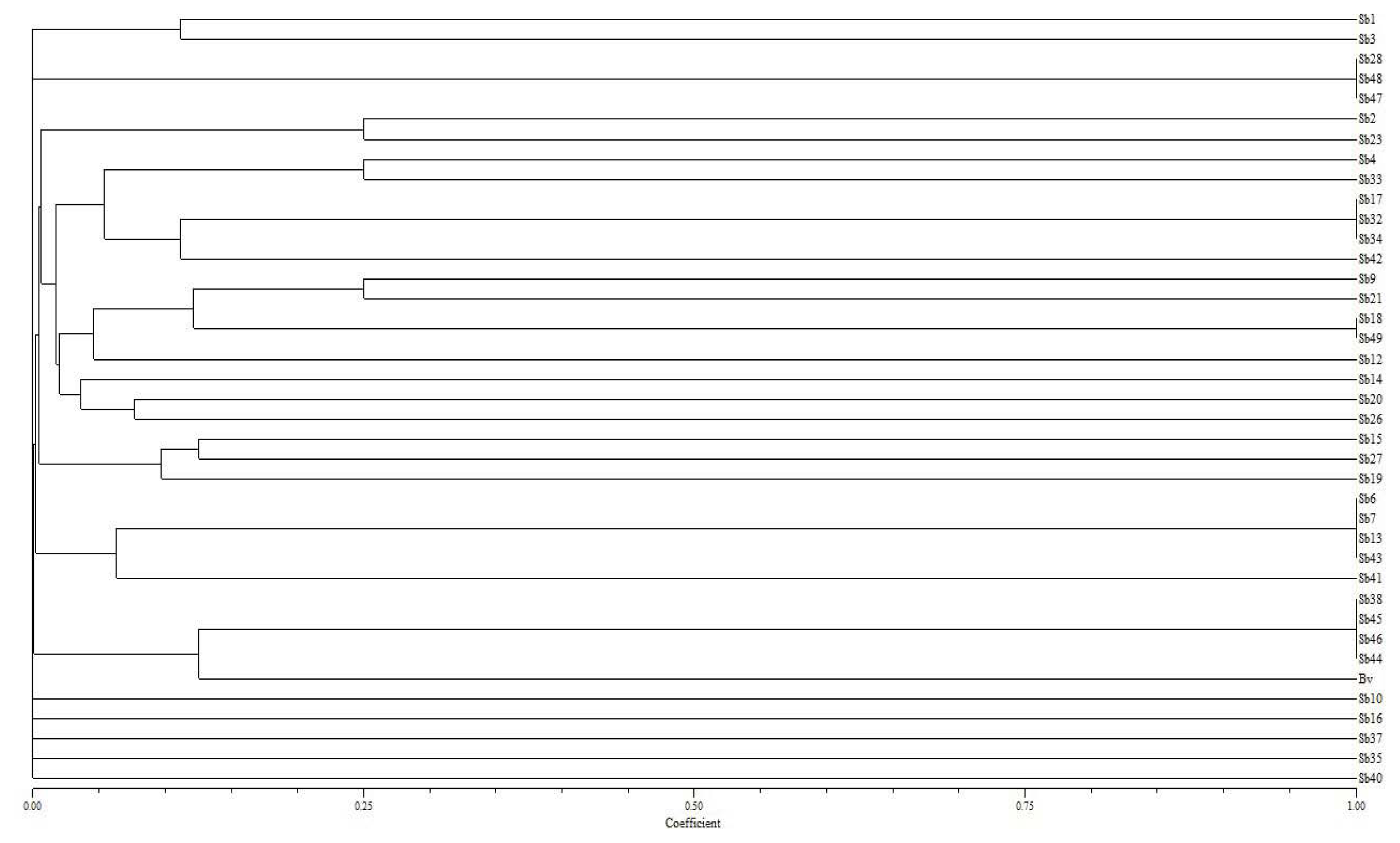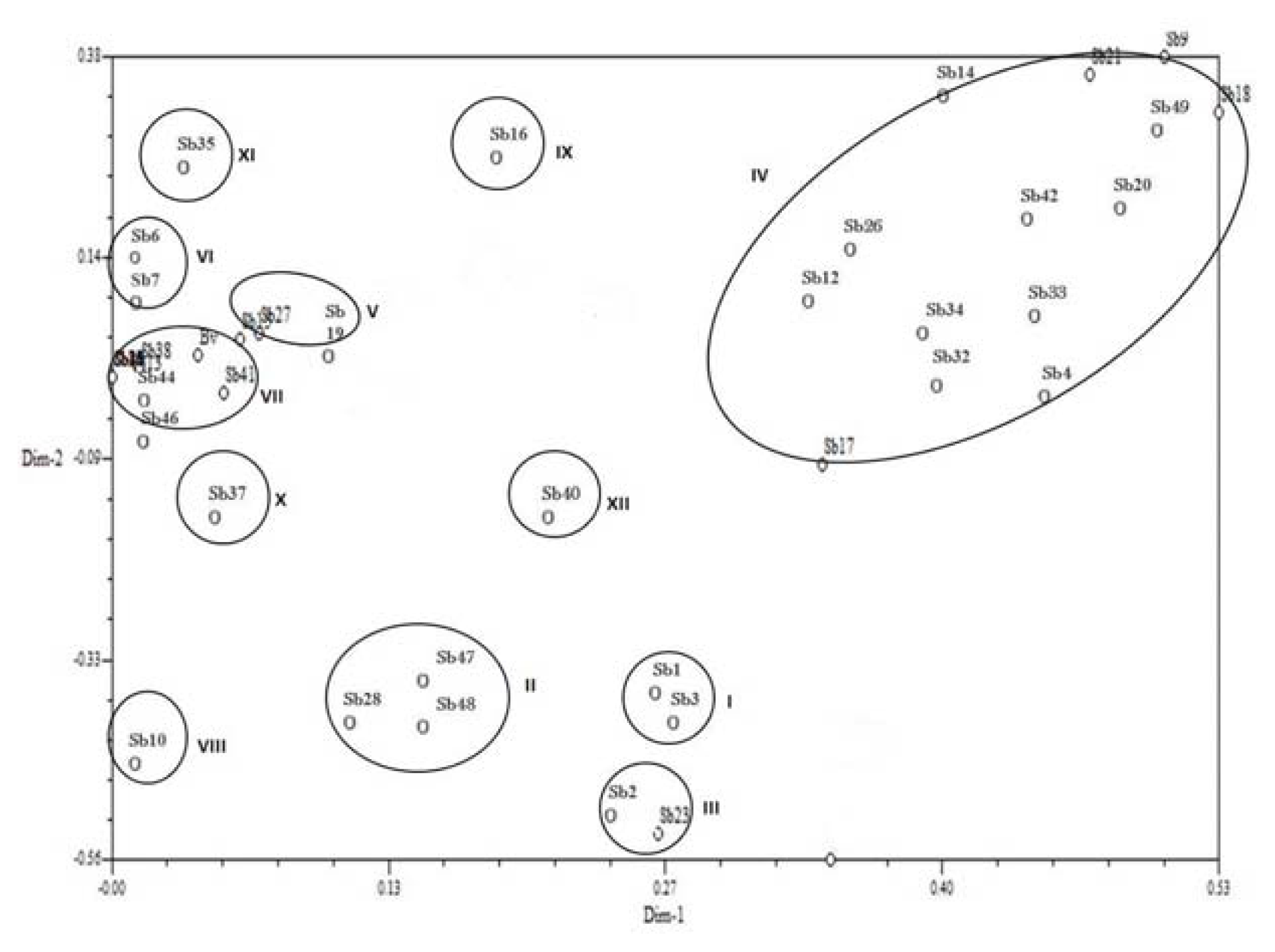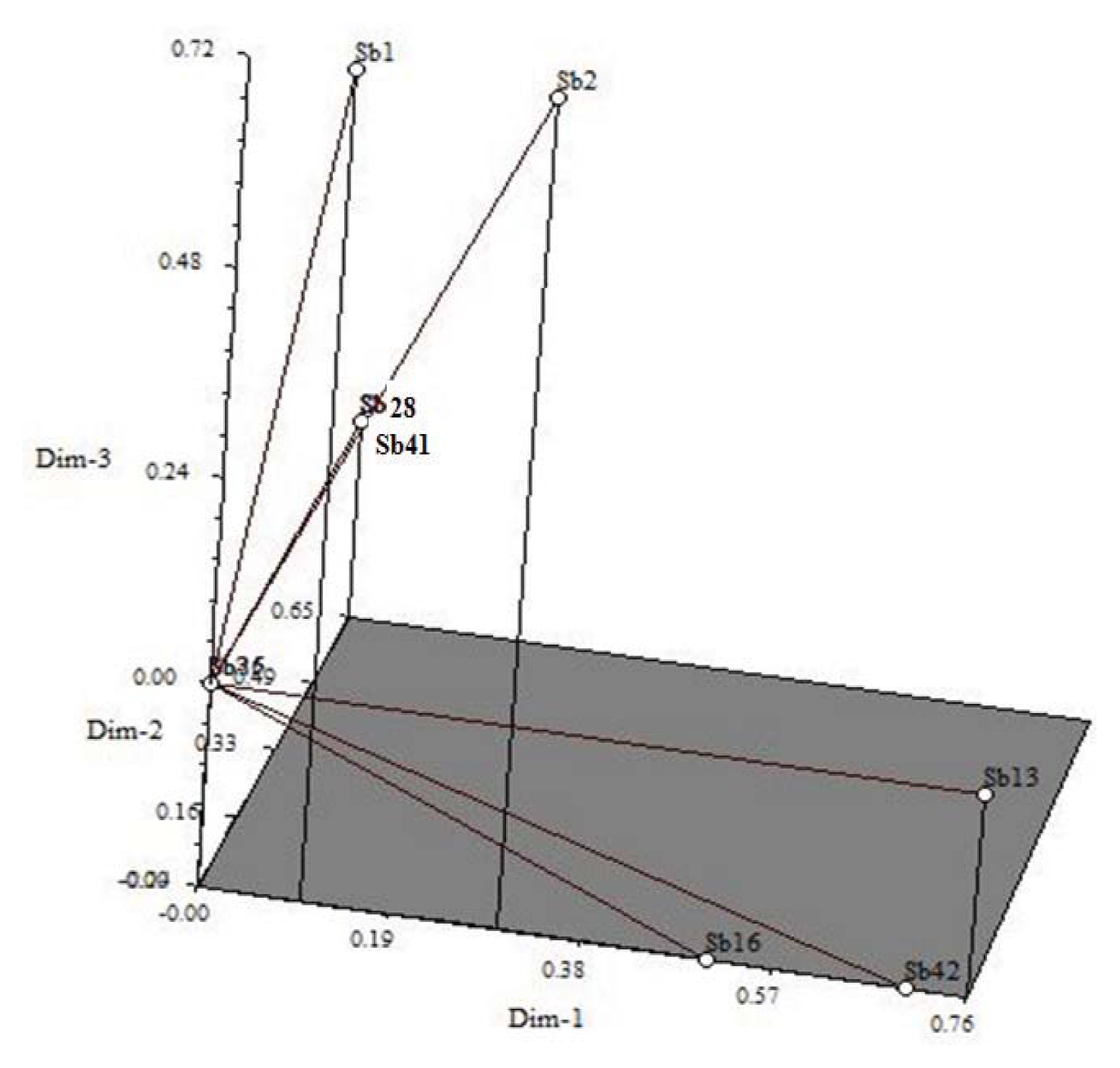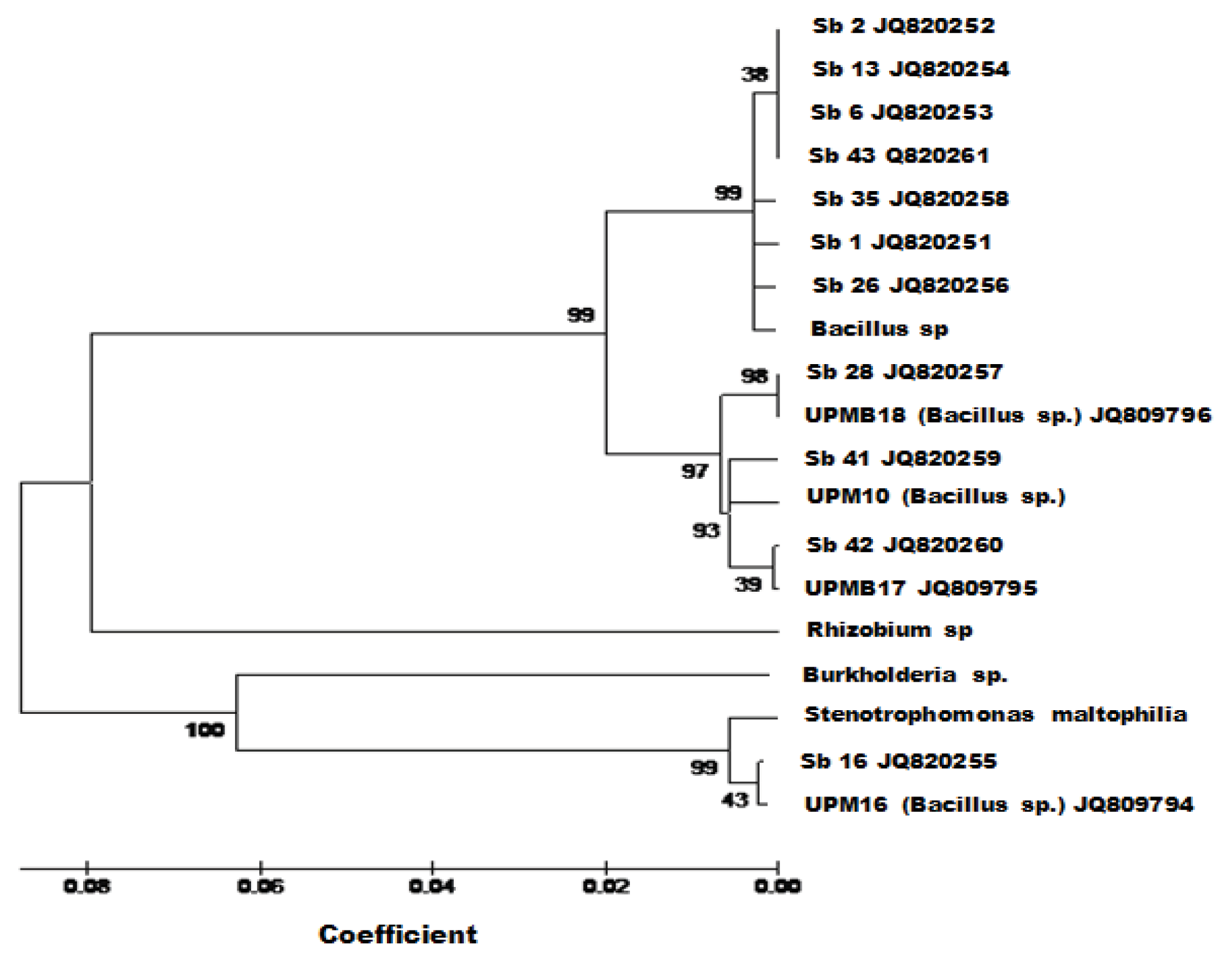Biomolecular Characterization of Diazotrophs Isolated from the Tropical Soil in Malaysia
Abstract
:1. Introduction
2. Results
2.1. Biochemical Characteristics of Diazotrophs
2.2. Molecular Characteristics of Diazotrophs
2.2.1. Cluster Analysis
2.2.2. Principal Component Analysis (PCA)
2.2.3. Identification of Diazotrophs
2.2.4. Colonization and Efficiency of Biological Nitrogen Fixation (BNF) by Sb16 and Sb26
3. Discussion
4. Experimental Section
4.1. Collection and Isolation of Diazotrophs
4.2. Estimation of Nitrogenase Enzyme Activity
4.3. Determination of Indoleacetic Acid (IAA) Production
4.4. Determination of CelluSlase Activity
4.5. Determination of Sugar Consumption
4.6. Strain Diversity and Diazotrophs Identification
4.6.1. DNA Extraction and Primers
4.6.2. PCR Protocols and Gel Electrophoresis
4.6.3. Strain Identification by Partial Gene Sequencing
4.6.4. Determination of Nitrogen Fixation (15N Isotope Dilution Technique)
4.6.5. Observation of Root Colonization Using SEM and TEM
4.7. Statistical Analysis
5. Conclusions
Acknowledgements
Conflicts of Interest
Abbreviations
| a.e. | atom excess |
| ANOVA | analysis of variance |
| ARA | acetylene reduction assay |
| DGGE | Denaturing Gradient Gel Electrophoresis |
| PC | principal components |
| SEM | scanning electron microscopy |
| TEM | transmission electron microscopy |
References
- Glick, B.R. Modulution of plant ethylene levels by the bacterial enzyme ACC deaminase. FEMS Microbiol. Lett 2005, 251, 1–7. [Google Scholar]
- Naher, U.A.; Radziah, O.; Halimi, M.S.; Shamsuddin, Z.H.; Razi, M.I. Effect of root exuded specific sugars on biological nitrogen fixation and growth promotion in rice (Oryza sativa). Aust. J. Crop Sci 2011, 5, 1210–1217. [Google Scholar]
- Hsu, S.-F.; Buckley, D.H. Evidence for the functional significance of diazotroph community structure in soil. ISME J 2009, 3, 124–136. [Google Scholar]
- Bagwell, C.E.; Piceno, Y.M.; Ashburne-Lucas, A.M.Y.; Charles, R.L. Physiological diversity of the rhizosphere diazotroph assemblages of selected salt marsh grasses. Appl. Environ. Microbiol 1998, 10, 4276–4282. [Google Scholar]
- Ludwig, W.; Amann, R.; Martinez-Romero, E.; Schönhuber, W.; Bauer, S.; Neef, A.; Karl-Heinz, S. rRNA based identification and detection systems for rhizobia and other bacteria. Plant Soil 1998, 204, 1–19. [Google Scholar]
- Versalovic, J.; de Bruijn, F.J.; Lupski, J.R. Physical Structure and Analysis Chapman and Hall. In Bacterial Genomes; de Bruijn, F.J., Lupski, J.R., Weinstock, G.M., Eds.; Kluwer Academic Publishers: Norwell, MA, USA, 1997; pp. 552–558. [Google Scholar]
- Singh, R.; Mazumdar, P.B.; Sharma, G.D. Molecular characterization of genetic diversity of N2 fixing microbes of some wild legume plants of manipur—A review. J. Biol. Environ. Sci 2010, 6, 102–108. [Google Scholar]
- Naher, U.A.; Radziah, O.; Shamsuddin, Z.H.; Halimi, M.S.; Razi, M.I. Isolation of diazotrophs from different soils of Tanjong Karang rice growing area in Malaysia. Int. J. Agric. Biol 2009, 11, 547–552. [Google Scholar]
- Verma, S.C.; Ladha, J.K.; Tripathi, A.K. Evaluation of plant growth promoting and colonization ability of endophytic diazotrophs from deep water rice. J. Biotechnol 2001, 91, 127–141. [Google Scholar]
- Hutsch, B.W.; Augustin, J.; Merbach, W. Plant rhizodeposition—An important source for carbon turnover in soils. J. Plant Nut. Soil Sci 2002, 165, 397–407. [Google Scholar]
- Naher, U.A.; Radziah, O.; Halimi, M.S.; Shamsuddin, Z.H.; Mohd Razi, I. Effect of inoculation on root exudates carbon sugar and amino acids production of different rice varieties. Res. J. Microbiol 2008, 3, 580–587. [Google Scholar]
- LaRocque, J.R.; Bergholz, P.W.; Bagwell, C.E.; Lovell, C.R. Influence of host plant-derived and abiotic environmental parameters on the composition of the diazotroph assemblage associated with roots of Juncus roemerianus. Antonie Van Leeuwenhoek 2004, 86, 249–261. [Google Scholar]
- Ueda, T.; Suga, Y.; Yahiro, N.; Matsuguchi, T. Remarkable n2-fixing bacterial diversity detected in rice roots by molecular evolutionary analysis of nifH gene sequences. J. Bacteriol 1995, 177, 1414–1417. [Google Scholar]
- Latif, M.A.; Rafii, M.Y.; Rahman, M.M.; Talukdar, M.R.B. Microsatellite and minisatellite markers based DNA fingerprinting and genetic diversity of blast and ufra resistant genotypes. C. R. Biol. 2011, 334, 282–289. [Google Scholar]
- Rafii, M.Y.; Shabanimofrad, M.; Puteri Edaroyati, M.W.; Latif, M.A. Analysis of the genetic diversity of physic nut, Jatropha curcas accessions using RAPD-PCR molecular markers in Peninsular Malaysia. Mol. Biol. Rep 2012, 39, 6505–6511. [Google Scholar]
- Shabanimofrad, M.; Rafii, M.Y.; Puteri Edaroyati, M.W.; Biabani, A.R.; Latif, M.A. Phenotypic, genotypic and genetic divergence found in 48 newly collected Malaysian accessions of Jatropha curcas L. Indust. Crops Prod 2013, 42, 543–551. [Google Scholar]
- Dommelen, A.V.; Bastelaere, E.V.; Keijers, V.; Vanderleyden, J. Genetics of Azospirillum brasilense with respect to ammonium transport, sugar, uptake and chemotaxis. Plant Soil 1997, 194, 155–160. [Google Scholar]
- Park, M.; Kin, C.; Yang, J.; Lee, H.; Shin, W.; Kim, S.; Sa, T. Isolation and characterization of diazotrophic growth promoting bacteria from rhizosphere of agricultural crops of Korea. Microbiol. Res 2005, 160, 127–133. [Google Scholar]
- Schmid, M.; Hartmann, A. Molecular Phylogeny and Acology of Root Associated Diazotrophic and Probacteria. In Associative and Endophytic Nitrogen-Fixing Bacteria and Cyanobacterial Association; Elmerich, C., Newton, W.E., Eds.; Kluwer Academic Publishers: Dordrecht, The Netherlands, 2003; pp. 21–40. [Google Scholar]
- Gillis, M.; van Van, T.; Bardin, R.; Goor, M.; Hebnar Willems, P. Polyphasic taxonomy in the genus Burkholderia leading to an emended description of the genus and proposition of Burkholderia vietnamiensis, sp. nov. for n2-fixing isolates from rice in Vietnam. Int. J. Syst. Bacteriol 1995, 45, 274–289. [Google Scholar]
- Cleveland, C.C.; Townsend, A.R.; Schimel, D.S.; Fisher, H.; Howarth, R.W.; Hedin, L.O. Global patterns of terrestrial biologicsal nitrogen (N2) fixation in natural ecosystems. Global Biogeochem. Cycles 1999, 13, 623–645. [Google Scholar]
- Mirza, M.S.; Rasul, G.; Mehnaz, S.; Ladha, J.K.; So, R.B.; Ali, S.; Malik, K.A. Beneficial Effects of Nitrogen-Fixing Bacteria on Rice. In The Quest for Nitrogen Fixation in Rice; Ladha, J.K., Reddy, P.M., Eds.; IRRI: Manila, Philippines, 2000; pp. 191–204. [Google Scholar]
- Malik, K.A.; Mirza, M.S.; Hassan, U.; Mehnaz, S.; Rasul, G.; Haurat, J.; Bauy, R.; Normanel, P. The Role of Plant Associated Beneficial Bacteria in Rice-Wheat Cropping System. In Biofertilisers in Action; Kennedy, I.R., Chaudhry, A.T.M.A., Eds.; Rural Industries Research and Development Corporation: Canberra, Canada, 2002; pp. 73–83. [Google Scholar]
- Govindarajan, M.; Kwon, S.W.; Weon, H.Y. Isolation molecular characterization and growth-promoting activities of endophytic sugarcane diazotroph Klebsiella sp. World J. Microbiol. 2007, 23, 997–1006. [Google Scholar]
- Prasad, G.; James, E.K.; Mathan, N.; Reddy, P.M.; Reinhold-Hurek, B.; Ladha, J.K. Endophytic colonization of rice by a diazotrophic strain of Serratia marcescens. J. Bacteriol 2001, 183, 2634–2645. [Google Scholar]
- Elbeltagy, A.; Nishioka, K.; Sato, T.; Suzuki, H.; Ye, B.; Hamada, T. Endophytic colonization and in planta nitrogen fixation by a Herbaspirillum sp. isolated from wild rice species. Appl. Environ. Microbiol 2001, 67, 5285–5293. [Google Scholar]
- Gordon, D.A.; Weber, R.P. Colorimetric estimation of indole-3-acetic acid. Plant Physiol 1951, 26, 192–195. [Google Scholar]
- James, E.K.; Olivares, F.L.; de Oliveira, A.L.; dos Reis, F.B.; da Silva, L.G., Jr; Reis, V.M. Further observations on the interaction between sugar cane and Gluconacetobacter diazotrophicus under laboratory and greenhouse conditions. J. Exp. Bot. 2001, 52, 747–760. [Google Scholar]
- Egener, T.; Hurek, T.; Reinhold-Hurek, B. Endophytic expression of nif genes of Azoarcus sp. strain BH72 in rice roots. Mol. Plant-Microbe Interact. 1999, 12, 813–819. [Google Scholar]
- Versalovic, J.; Koeuth, T.; Lupski, J.R. Distribution of repetitive DNA sequences in eubcteria and application to fingerprinting of bacterial genomes. Nucleic Acids Res 1991, 19, 6823–6831. [Google Scholar]
- Thompson, J.D.; Higgins, D.G.; Gibson, T.J.; Clustal, W. Improving the sensitivity of progressive multiple sequence alignment through sequence weighting, position-specific gap penalties and weight matrix choice. Nucleic Acids Res 1994, 22, 4673–4680. [Google Scholar]
- Saitou, N.; Nei, M. The neighbor-joining method: A new method for reconstructing phylogenetic trees. Mol. Biol. Evol 1987, 4, 406–425. [Google Scholar]
- Felsenstein, J. Confidence limits on phylogenies: An approach using the bootstrap. Evolution 1985, 39, 783–791. [Google Scholar]
- Tamura, K.; Dudley, J.; Nei, M.; Kumar, S. MEGA4: Molecular evolutionary genetics analysis (MEGA) software version 4.0. Mol. Biol. Evol 2007, 24, 1596–1599. [Google Scholar]
- Boddy, R.M. Methods for quantification of nitrogen fixation associated with gramineae. Crit. Rev. Plant Sci 1987, 6, 209–266. [Google Scholar]
- Bremner, J.M. Nitrogen Total. In Methods of Soil Analysis (Part 3). Chemical Methods; Spark, D.L., Page, A.L., Helmke, P.A., Loeppert, R.H., Sultanpour, P.N., Tabatabai, M.A., Johnsto, C.T., Sumner, M.E., Eds.; American society of Agronomy, Inc.: Madison, WI, USA, 1996; pp. 1085–1121. [Google Scholar]
- Benton, J., Jr. Laboratory Guide for Conducting Soil Tests and Plant Analysis; CRC Press LLC: New York, NY, USA, 2001; pp. 27–41. [Google Scholar]
- Warembough, F.R. Nitrogen Fixation in Soil and Plant System. In Nitrogen Isotope Technique; Knowles, R., Blackburn, T.H., Eds.; Academic Press Inc: San Diego, CA, USA, 1993; pp. 127–155. [Google Scholar]
- Amin, M.A.; Uddin, M.A.; Hossain, M.A. Regeneration study of some Indica rice cultivars followed by Agrobacterium-Mediated transformation of highly regenerable cultivar BR-8. J. Biol. Sci 2004, 4, 207–211. [Google Scholar]
- Jaccard, P. Nouvelles recherches sur la distribution florale. Bul. Soc. Vaudoise Sci. Nat 1908, 44, 223–270. [Google Scholar]
- Latif, M.A.; Rahman, M.M.; Kabir, M.S.; Ali, M.A.; Islam, M.T.; Rafii, M.Y. Genetic diversity analyzed by quantitative traits among rice (Oryza sativa L.) genotypes resistant to blast disease. Afr. J. Microbiol. Res 2011, 5, 4383–4391. [Google Scholar]
- Mahmuda, F.; Rasul, M.G.; Rahima, M.A. Genetic diversity analysis in some advanced lines of Brassica napus. Sci. Asia 2008, 34, 432–434. [Google Scholar]





| Isolate | ARA (μmol·C2H4−1·cfu−1·h−1) | Cellulose degradation | IAA production (mg·L−1) | Sugar consumption (%) | ||||
|---|---|---|---|---|---|---|---|---|
| Glucose | Fructose | Sucrose | Arabinose | Galactose | ||||
| Sb1 | 1.9 × 10−8 | − | 26.0 | 100.0 | 98.25 | 72.00 | 89.00 | 85.00 |
| Sb2 | 1.6 × 10−9 | + | 66.7 | 100.0 | 96.00 | 79.33 | 76.32 | 82.33 |
| Sb3 | 2.3 × 10−10 | − | 48.0 | nd | nd | nd | nd | nd |
| Sb4 | nd | + | 32.0 | nd | nd | nd | nd | nd |
| Sb6 | 1.3 × 10−7 | + | 57.6 | 90.54 | 100.0 | 86.84 | 83.00 | 98.00 |
| Sb7 | nd | + | 63.0 | nd | nd | nd | nd | nd |
| Sb9 | nd | + | 34.02 | nd | nd | nd | nd | nd |
| Sb10 | 2.7 × 10−10 | − | 34.2 | nd | nd | nd | nd | nd |
| Sb12 | 1.23× 10−7 | + | 16.49 | nd | nd | nd | nd | nd |
| Sb13 | 3.1 × 10−9 | − | 54.2 | 97.33 | 96.00 | 96.00 | 100.0 | 100.0 |
| Sb14 | 2.3 × 10−7 | − | 32.03 | nd | nd | nd | nd | nd |
| Sb15 | 1.8 × 10−6 | − | 24.41 | nd | nd | nd | nd | nd |
| Sb16 | 1.4 × 10−7 | + | 59.5 | 90.67 | 76.00 | 80.00 | 98.67 | 100.0 |
| Sb17 | 2.1 × 10−7 | − | 22.43 | nd | nd | nd | nd | nd |
| Sb18 | 2.7 × 10−10 | − | 43.0 | nd | nd | nd | nd | nd |
| Sb19 | 1.7 × 10−7 | − | 17.14 | nd | nd | nd | nd | nd |
| Sb20 | 3.9 × 10−9 | − | 52.0 | nd | nd | nd | nd | nd |
| Sb21 | 2.3 × 10−7 | − | 13.21 | nd | nd | nd | nd | nd |
| Sb23 | 1.7 × 10−7 | − | 16.32 | nd | nd | nd | nd | nd |
| Sb26 | 2.9 × 10−10 | + | 15.0 | 96.00 | 93.33 | 69.33 | 88.00 | 86.91 |
| Sb27 | 1.8 × 10−7 | − | nd | nd | nd | nd | nd | |
| Sb28 | 2.1 × 10−9 | + | 51.0 | 94.67 | 100.0 | 94.67 | 93.33 | 75.00 |
| Sb32 | 5.4 × 10−10 | + | 62.0 | nd | nd | nd | nd | nd |
| Sb33 | 1.8 × 10−10 | + | 22.0 | nd | nd | nd | nd | nd |
| Sb34 | 4.9 × 10−7 | + | 47.0 | nd | nd | nd | nd | nd |
| Sb35 | 1.36 × 10−6 | − | 30.4 | 89.00 | 96.76 | 79.32 | 90.00 | 84.54 |
| Sb37 | 2.5 × 10−10 | + | 49.0 | nd | nd | nd | nd | nd |
| Sb38 | 6.1 × 10−11 | + | 31.0 | nd | nd | nd | nd | nd |
| Sb40 | 1.2 × 10−8 | − | 18.04 | nd | nd | nd | nd | nd |
| Sb41 | 9.1 × 10−10 | + | 53.0 | 89.53 | 100.0 | 81.82 | 96.00 | 96.33 |
| Sb42 | 6.1 × 10−11 | + | 60.0 | 91.00 | 98.00 | 96.00 | 85.00 | 100.0 |
| Sb43 | 4.2 × 10−12 | − | 21.0 | nd | nd | nd | nd | nd |
| Sb44 | 5.1 × 10−11 | − | 15.61 | nd | nd | nd | nd | nd |
| Sb45 | 7.0 × 10−11 | + | 18.1 | nd | nd | nd | nd | nd |
| Sb46 | 6.1 × 10−10 | + | 41.0 | nd | nd | nd | nd | nd |
| Sb47 | 2.2 × 10−9 | + | 24.0 | nd | nd | nd | nd | nd |
| Sb48 | 6.3 × 10−11 | + | 20.0 | nd | nd | nd | nd | nd |
| Sb49 | 1.1 × 10−11 | + | 22.4 | nd | nd | nd | nd | nd |
| Cluster I | Cluster II | Cluster III | Cluster IV | Cluster V | Cluster VI | Cluster VII | Cluster VIII | Cluster IX | Cluster X | Cluster XI | Cluster XII | |
|---|---|---|---|---|---|---|---|---|---|---|---|---|
| Cluster I | 0 | |||||||||||
| Cluster II | 0.039 | 0 | ||||||||||
| Cluster III | 0.021 | 0.024 | 0 | |||||||||
| Cluster IV | 0.018 | 0.026 | 0.022 | 0 | ||||||||
| Cluster V | 0.022 | 0.030 | 0.039 | 0.018 | 0 | |||||||
| Cluster VI | 0.019 | 0.043 | 0.022 | 0.021 | 0.010 | 0 | ||||||
| Cluster VII | 0.017 | 0.044 | 0.025 | 0.020 | 0.021 | 1.000 | 0 | |||||
| Cluster VIII | 0.019 | 0.012 | 0.026 | 0.021 | 0.011 | 1.000 | 1.000 | 0 | ||||
| Cluster IX | 0.018 | 0.043 | 0.025 | 0.025 | 0.010 | 1.000 | 1.000 | 1.000 | 0 | |||
| Cluster X | 0.019 | 0.029 | 0.024 | 0.022 | 0.010 | 1.000 | 1.000 | 1.000 | 1.000 | 0 | ||
| Cluster XI | 0.018 | 0.044 | 0.025 | 0.021 | 0.103 | 1.000 | 1.000 | 1.000 | 1.000 | 1.000 | 0 | |
| Cluster XII | 0.019 | 0.029 | 0.022 | 0.010 | 0.03 | 1.000 | 1.000 | 1.000 | 1.000 | 1.000 | 1.000 | 0 |
| Strains | First four principle components | |||
|---|---|---|---|---|
| PC1 | PC2 | PC3 | PC4 | |
| Variation accounted for | 5.04 | 10.27 | 16.62 | 20.35 |
| Sb1 | 0.00 | 0.00 | 0.00 | 0.00 |
| Sb2 | 0.17 | −0.38 | −0.43 | 0.23 |
| Sb3 | 0.00 | 0.00 | 0.00 | 0.00 |
| Sb4 | 0.34 | −0.56 | 0.04 | −0.07 |
| Sb6 | 0.01 | 0.00 | 0.02 | −0.03 |
| Sb7 | 0.02 | 0.00 | 0.03 | −0.02 |
| Sb9 | 0.51 | 0.38 | −0.33 | −0.15 |
| Sb10 | 0.00 | 0.00 | 0.00 | 0.00 |
| Sb12 | 0.13 | 0.08 | 0.01 | 0.01 |
| Sb13 | 0.01 | 0.00 | 0.03 | −0.02 |
| Sb14 | 0.18 | 0.11 | 0.17 | 0.22 |
| Sb15 | 0.06 | 0.05 | 0.14 | 0.52 |
| Sb16 | 0.00 | 0.00 | 0.00 | 0.00 |
| Sb17 | 0.34 | −0.10 | 0.46 | −0.19 |
| Sb18 | 0.53 | 0.31 | 0.02 | 0.03 |
| Sb19 | 0.18 | 0.12 | 0.17 | 0.56 |
| Sb20 | 0.08 | 0.01 | 0.22 | −0.06 |
| Sb21 | 0.47 | 0.35 | −0.33 | −0.15 |
| Sb23 | 0.26 | −0.53 | −0.42 | 0.21 |
| Sb26 | 0.23 | 0.07 | 0.29 | −0.01 |
| Sb27 | 0.07 | 0.05 | 0.15 | 0.57 |
| Sb28 | 0.00 | 0.00 | 0.00 | 0.00 |
| Sb32 | 0.31 | −0.11 | 0.44 | −0.18 |
| Sb33 | 0.35 | −0.44 | 0.32 | −0.20 |
| Sb34 | 0.33 | −0.12 | 0.45 | −0.17 |
| Sb35 | 0.00 | 0.00 | 0.00 | 0.00 |
| Sb37 | 0.00 | 0.00 | 0.00 | 0.00 |
| Sb38 | 0.01 | 0.01 | 0.04 | 0.06 |
| Sb40 | 0.00 | 0.00 | 0.00 | 0.00 |
| Sb41 | 0.05 | −0.02 | 0.12 | −0.06 |
| Sb42 | 0.12 | −0.03 | 0.30 | −0.12 |
| Sb43 | 0.01 | 0.00 | 0.03 | −0.03 |
| Sb44 | 0.01 | 0.01 | 0.03 | 0.05 |
| Sb45 | 0.02 | 0.00 | 0.03 | 0.09 |
| Sb46 | 0.03 | 0.01 | 0.02 | 0.08 |
| Sb47 | 0.01 | 0.00 | 0.01 | 0.00 |
| Sb48 | 0.00 | 0.01 | 0.01 | 0.00 |
| Sb49 | 0.23 | 0.26 | 0.02 | 0.01 |
| *Bv | 0.04 | 0.03 | 0.07 | 0.11 |
| Variable | PC1 | PC2 | PC3 |
|---|---|---|---|
| proportion | 0.51 | 0.22 | 0.12 |
| ARA | −0.039 | −0.751 | −0.276 |
| IAA | −0.893 | −0.009 | 0.255 |
| Glucose | 0.052 | −0.077 | 0.167 |
| Fructose | 0.030 | −0.244 | 0.268 |
| Sucrose | −0.383 | −0.253 | −0.316 |
| Arabinose | −0.007 | 0.033 | −0.742 |
| Galactose | −0.223 | 0.552 | −0.329 |
| Rice genotype | Diazotrophs | 15N (%a.e.) | Tissue N (%) | N fixed (mg·plant−1) | % Nfda | N fixed kg· (ha−1) |
|---|---|---|---|---|---|---|
| MR219 | Control | 0.76 ± 0.02 | 2.3 ± 0.16 | – | – | – |
| Sb16 | 0.57 ± 0.02 | 3.6 ± 0.14 | 0.89 ± 0.16 | 23 | 11 | |
| Sb26 | 0.59 ± 0.01 | 3.8 ± 0.10 | 0.84 ± 0.18 | 22 | 13 | |
| Mayang Segumpal | Control | 0.80 ± 0.03 | 2.2 ± 0.14 | – | – | – |
| Sb16 | 0.60 ± 0.01 | 3.9 ± 0.10 | 0.93 ± 0.11 | 22 | 11 | |
| Sb26 | 0.58 ± 0.02 | 4.2 ± 0.10 | 1.00 ± 0.09 | 24 | 12 | |
| SNo. | Soil series/types | Diazotrophs isolated | Soil pH | Organic carbon (%) | Total nitrogen (%) |
|---|---|---|---|---|---|
| 1 | Jawa | Sb1, Sb2, Sb26, Sb28, Sb32 | 4.71 c | 6.67 c | 0.44 c |
| 2 | Serong | Sb3, Sb4, Sb17, Sb41, Sb42 | 4.90 b | 2.94 e | 0.38 d |
| 3 | Organic Clay & Muck | Sb43, Sb44, Sb45, Sb46, Sb19, Sb21, Sb47, Sb48, Sb49 | 4.50 d | 9.11 a | 0.66 a |
| 4 | Sedu | Sb6, Sb16, Sb18, Sb35, Sb37, Sb38 | 4.40 e | 7.89 b | 0.55 b |
| 5 | Bernam | Sb7, Sb9, Sb12, Sb20, Sb40 | 4.87 b | 5.43 c | 0.24 e |
| 6 | Bakau | Sb10, Sb13, Sb14, Sb23 | 5.18 a | 3.08 e | 0.27 e |
| 7 | Brown Clay | Sb15, Sb27, Sb33, Sb34 | 4.63 d | 5.13 d | 0.33 d |
© 2013 by the authors; licensee MDPI, Basel, Switzerland This article is an open access article distributed under the terms and conditions of the Creative Commons Attribution license (http://creativecommons.org/licenses/by/3.0/).
Share and Cite
Naher, U.A.; Othman, R.; Latif, M.A.; Panhwar, Q.A.; Amaddin, P.A.M.; Shamsuddin, Z.H. Biomolecular Characterization of Diazotrophs Isolated from the Tropical Soil in Malaysia. Int. J. Mol. Sci. 2013, 14, 17812-17829. https://doi.org/10.3390/ijms140917812
Naher UA, Othman R, Latif MA, Panhwar QA, Amaddin PAM, Shamsuddin ZH. Biomolecular Characterization of Diazotrophs Isolated from the Tropical Soil in Malaysia. International Journal of Molecular Sciences. 2013; 14(9):17812-17829. https://doi.org/10.3390/ijms140917812
Chicago/Turabian StyleNaher, Umme Aminun, Radziah Othman, Mohammad Abdul Latif, Qurban Ali Panhwar, Puteri Aminatulhawa Megat Amaddin, and Zulkifli H Shamsuddin. 2013. "Biomolecular Characterization of Diazotrophs Isolated from the Tropical Soil in Malaysia" International Journal of Molecular Sciences 14, no. 9: 17812-17829. https://doi.org/10.3390/ijms140917812




